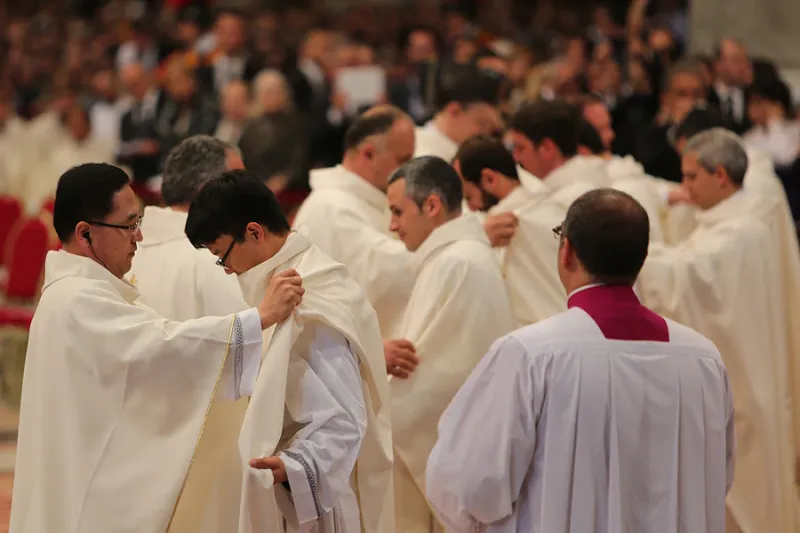 Newly ordained priests are vested during their Mass of Ordination in St. Peter’s Basilica, April 26, 2015. / Bohumil Petrik/CNA.
Newly ordained priests are vested during their Mass of Ordination in St. Peter’s Basilica, April 26, 2015. / Bohumil Petrik/CNA.
Washington D.C., Jul 26, 2021 / 06:01 am (CNA).
In preparation for Mass, priests make ready the sacred vessels, linens, and vestments that they use. Afterward, they take care to clean up. Every action they take, every word they say, stresses the importance of the Mass.
Two priests located in Washington, D.C., Fr. William Foley at the Shrine of the Most Blessed Sacrament and Fr. Charles Gallagher at Immaculate Conception, gave a behind-the-scenes look to EWTN News In Depth July 16.
Preparations for Mass are made in the sacristy.
“One of the first things I do is to make sure the chalice is ready,” Fr. Foley said.
Priests often receive a chalice at their ordination. His family, he said, purchased his from a chalice maker in Montreal, Canada, over 42 years ago.
Both the chalice and the paten, a plate that holds the hosts, consist of precious metals.
“The reason why the paten is – and the chalice – are so beautiful,” Fr. Gallagher said, is “because they really touch God. And we want to give the best we have to God.”
Linens also play a critical role in the Mass. The corporal, which takes its name from the Latin word for “body,” is a square linen cloth that often has a cross embroidered on it.
It exists, Fr. Foley said, so that “during the Mass, when the priest breaks the host, nothing falls off of it.” Instead, the cloth catches the body of Christ.
Fr. Gallagher also discussed the purificator.
“So after the chalice is used,” he said, “I consume the remaining precious blood and I rinse it with water and then I use the purificator to wipe it and to dry it.”
After the vessels and linens are prepared, the priest vests.
First, the priest “says a special prayer to wash his hands,” Fr. Gallagher said.
“This prayer in Latin says, ‘Give, Lord, strength to my hands to wipe out all stain so that, without pollution of mind or body, I may dare to serve You,’” he translated.
One layer at a time, the priest gets ready for Mass.
“The first is called an amice,” said Fr. Gallagher, pointing to a white cloth that wraps around the shoulders and neck. “This is really meant to be like a helmet of salvation.”
Then, “over the amice, I put on the alb,” he said. The floor-length white vestment with sleeves is put on with the prayer “Wash me clean, Lord, and cleanse me from my sin; that I may rejoice and be glad unendingly with them that have washed their robes in the blood of the Lamb.”
Around the alb, the priest places a cincture, the prayer for which is: “Gird me, Lord, with the belt of faith, my loins with the virtue of chastity, and extinguish in them the humour of lust; that the strength of all chastity may ever abide in me.”
Next comes the stole, at which the priest prays, “Restore to me, Lord, I beseech Thee, the stole of immortality, which I lost in the transgression of the first father; and, though unworthy I presume to approach Thy sacred mystery with this garment, grant that I may merit to rejoice in it forever.”
Finally, the priest dons the chasuble, a sleeveless and often ornate outer vestment, praying, “O Lord, who said: my yoke is sweet and my burden light: grant that I may be able so to bear it, so that I may be able to obtain Thy grace.”
The point of the prayers for the vestments “is that the priest is covering up his humanity, because it’s Our Lord Jesus who celebrates the Mass,” Fr. Gallagher emphasized. “So all of these different elements help the priest realize it’s Our Lord Jesus who is taking over.”
He added, “Yes, he uses my voice, my hands, my gestures, but it’s really Our Lord and his power that is able to change the bread into his body.”
Following the Mass, the linens and the vessels must be cleaned.
“It’s washed in a very special way,” Fr. Foley said, pointing to the corporal. “Because it may, it comes in contact with the precious host, the precious blood.”
Fr. Gallagher added, “It would soak for a few days in water along with any other – the sacred linens.” That water is later “poured into a special sink that we call a sacrarium.”
The sacrarium, Fr. Foley said, “goes not into the sewer system, but into the dirt, into the ground,” so that “the precious body and blood of the Lord does not get mingled with sewage.”
Their actions and words point to the reverence due to the Mass and the body and blood of Christ.
“The Mass is actually not one of the most time-consuming things we do, but it is the most important thing we do,” Fr. Gallagher concluded. “So that’s why it’s sort of shrouded with all these special rituals, prayers of preparation to help the priest prepare and celebrate Mass very well. And that’s the most important thing he can do for his people.”

[…]






.jpg?w=800)
